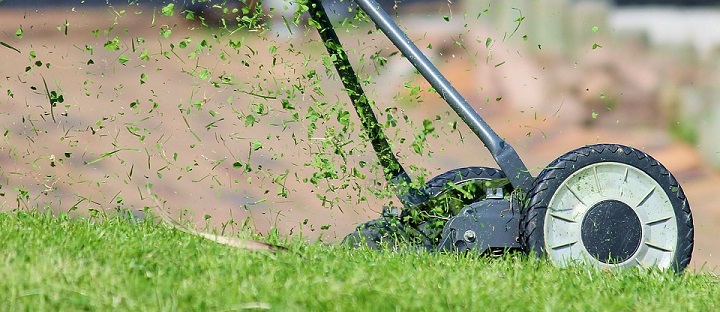
Not sure how to mow a lawn? Never done it before? Here's our step-by-step guide...
Mowing your lawn may seem like a simple and straightforward task, but there are a lot of things to think about. Like most plants, if you cut off the growing point on grass, it can branch out and become denser, which results in a tightly woven turf. If you never cut your grass, on the other hand, it can begin to look more like a prairie rather than a garden lawn.
The act of mowing isn't what makes your lawn look good - the mowing height and mowing frequency is what determines how healthy and how attractive your lawn looks.
1. Invest in a good lawnmower.
First things first: Before you can learn how to mow your lawn, you will need to invest in a decent lawnmower that is up to snuff.
A good lawn mower will cut your grass quickly and cleanly, without requiring much maintenance to keep it running efficiently. Check out our guide to the different types of lawn mower to determine which one is right for you and your garden.
2. Begin with sharp blades.
If you're wondering how to mow a lawn effectively, ensure your blades are as sharp as can be. One of the most common mistakes people make when mowing the lawn is using tired, dull mower blades rather than sharp ones. Sharp blades result in clean cuts and last for longer, whereas dull blades will tear the grass, not cut it. When the grass is torn, it becomes stressed as its roots begin to get pulled out and the uncut part of the grass blade is harmed.
3. Mow a little bit at a time.
Many people use the 'one third' rule when it comes to mowing their lawn: you should only cut off one-third of your grass' length when mowing to prevent the grass from straining. Of all the tips on how to mow a lawn, this is one of the most important.
You should aim to cut as little as possible off at any given time. There's a reason why the top golf courses and football pitches in the world are cut multiple times a week. The less grass you cut off, the stronger, the denser and the less stressed the grass will become. To make things a little easier on your part, here is a rough guide to the cutting heights you should be aiming for depending on the type of grass in your garden:
- Bahiagrass, blue grama, buffalo grass or tall fescue: 2 to 3 inches
- Bentgrass: 0.25 to 1 inch
- Common Bermuda grass: 0.75 to 1.5 inches
- Hybrid Bermudagrass: 0.5 to 1 inch
- Centipede grass or zoysia grass: 1 to 2 inches
- Fine fescue or St Augustine grass: 1.5 to 2.5 inches
- Kentucky bluegrass: 1.75 to 2.5 inches
- Annual and perennial ryegrass: 1.5 to 2 inches
Find out what kind of grass is in your garden, and then adjust your mower accordingly.
4. Switch up your cutting patterns.
When learning how to mow your lawn, there are two types of pattern you can use. The first is back and forth - here you start at one side of your lawn, mow until you reach the other side and then come back. This is by far the most common cutting pattern, and it's the best pattern to use when mowing rectangular, standard lawns.
The second pattern is more of a circular one, which is often used with oddly-shaped gardens or those that have trees or flowerbeds in the centre. Here, you start by mowing your lawn in a circle, working your way outwards or inwards.
No matter which pattern you choose, be sure to alternate which way you go. If you use the first method and start left and mow right, the next time you mow, start right and mow to the left. This will help your grass to stay vertical and prevent it from leaning one way.
READ MORE: How to Mow the Edges of a Lawn
5. Use a mulching blade.
Mulching blades are a type of mowing blade that are designed to chop up grass clippings into little pieces so they can fall down into the lawn, decompose and provide fertiliser. Whilst most lawns may still need extra fertiliser on top of this, applying grass clippings can be a massive help.
6. Mow over your clippings.
When deciding which direction and pattern to mow in, you want to be mowing over the clippings produced in your previous cut. This causes the clippings to be cut up even finer, which means faster decomposition into fertiliser. However, it is important to change mowing patterns so that one side of your lawn doesn't receive more fertiliser than the other.
7. Never mow your lawn wet.
If there's one thing you take away from learning how to mow a lawn, it's to never mow your lawn when it is wet. This is because you are more likely to get ruts in your lawn, cutting unevenly and clumping up grass. It's better to play it safe and mow your lawn when it is dry. This is particularly true with a new lawn, where the grass doesn't have the deeper root system that an established lawn would have.
Regardless of the type of lawn you have in your garden, mowing your grass is one of the most important things you can do for a healthy lawn. If you learn how to mow a lawn efficiently and effectively, you will be a lot closer to achieving a lush green space that your neighbours will envy.
For more information on how to mow a lawn, get in touch with the lawn care professionals here at Lawn & Weed Expert today!
Contact Lawn & Weed Expert >